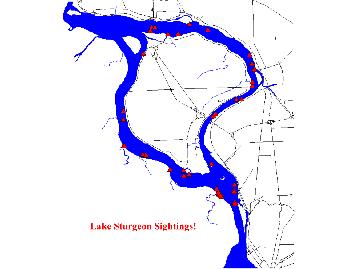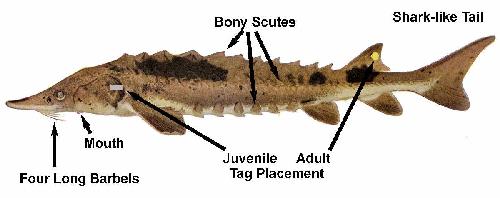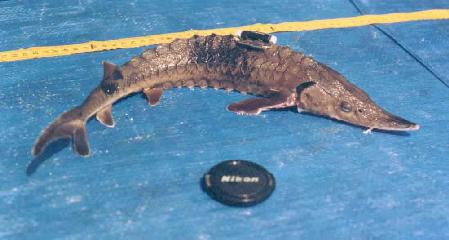
Historically, lake sturgeon were abundant in both Lakes Erie and Ontario. Commercial landings were as high as 5,187,000 pounds in Lake Erie (1885) and 546,000 (1879) pounds in Lake Ontario. More recently, landings by Canadian commercial operations reported 3,000 to 5,000 pounds from each lake in the late 1970s. Declines in both watersheds are most likely due to habitat loss and degradation and commercial exploitation. The current populations of lake sturgeon are greatly reduced with only remnant populations remaining. As a result, the lake sturgeon is listed as threatened in New York State, endangered in Pennsylvania, and a Federal Species of Special Concern.
The document titled: A Recovery Plan for the Lake Sturgeon (Acipenser fulvescens) in New York, authored by the New York State Department of Environmental Conservation (NYSDEC), establishes a goal, objectives, and tasks to restore self-sustaining populations of lake sturgeon. The first steps are to identify and prioritize the best potential areas for restoration and determine population dynamics of existing stocks. Within the Niagara River, a remnant population exists; however, information regarding population dynamics and habitat availability is lacking.

Recent-past and current sightings of lake sturgeon in the Niagara River suggest successful natural reproduction and age-class structure within the remaining population. This area seems to be one of only two areas in New York State known to exhibit successful natural reproduction. Better knowledge of the population characteristics is needed in the event of future enhancement efforts and/or restoration.
Concerns regarding the genetic heritage of current lake sturgeon populations, and the possible implications of deteriorating that composition due to lack of knowledge, has been a lingering issue for several years. Currently, our partners at the USGS-BRD office in Wellsboro, PA have monies to perform genetic analysis of tissue samples collected from lake sturgeon. This analysis is essential to future restoration efforts of lake sturgeon within the area due to possible population-specific habitat requirements. The LGLFRO has received FY98-99 funding to perform work which contributes to the objectives stated above. All information will be extended into a Recovery Plan for lower Great Lakes waters.
Sampling will commence in May, prior to the preferred spawning temperature (11-15o C), and continue as often and as long as feasible through September. Sample sites will be identified according to sightings provided by the local diving community and on a literature review of preferred habitat. Setlines and electrofishing will be utilized. Setlines will be set perpendicular with the shoreline, allowing for leader and hook to carry with the current. Equipment will be set overnight.
Data Collection:
All sturgeon caught will be placed in an aerated holding tank until measurements can be obtained. Fork length, total length, weight, and girth will be recorded on all lake sturgeon collected. In addition, pectoral spine and one-half square inch of fin tissue will be obtained for age estimation and genetic analysis, respectively. To prevent infection, all sampled areas will have iodine applied before and after tissue collection.
Tagging

All sturgeon will be tagged. A disc tag will be applied to adults (>36") and a Monel cattle ear tag will be applied to juvenile fish (<36"). Three adults and three juveniles each from the upper and lower river will also receive an ultrasonic transmitter for tracking the distribution, movement, and habitat use by these fish. Sonic tags will be applied externally, through the base of the dorsal fin on adults and scutes on juveniles, as implemented by other sturgeon researchers (Bain-Cornell, Hayes-ESF, Bruch-WI). Lake sturgeon will remain in the aerated tank for several hours, to assure complete recovery, prior to being released.
Tracking will be conducted daily, particularly for adults during the expected spawning period. Tracking will then be reduced to once, twice or three times per week, as deemed necessary, throughout the fall to early winter season. In the event tracking can continue over-winter, twice a month tracking will be conducted.

Latitude, longitude, near-bottom water temperature, dissolved oxygen, and velocity, depth, pH, conductivity, vegetation abundance, and substrate will be documented at each sampling location. Collecting this information at all sampling sites will provide an analysis of habitat types where lake sturgeon are collected and not collected and also will help verify the information provided by the SCUBA diving community.
Habitat utilization by lake sturgeon will be identified by lengthy residence time of the adults or juveniles in a particular area. Parameters, as stated above, will be surveyed in addition to macrobenthos during the post-spawning period. Global Positioning Systems (GPS) will be used to directly identify high use areas and incorporated into the station's geographic information system (GIS) database.
Background - A short, but very educational background of Lake Sturgeon in the Great Lakes.
Return to NDA Homepage